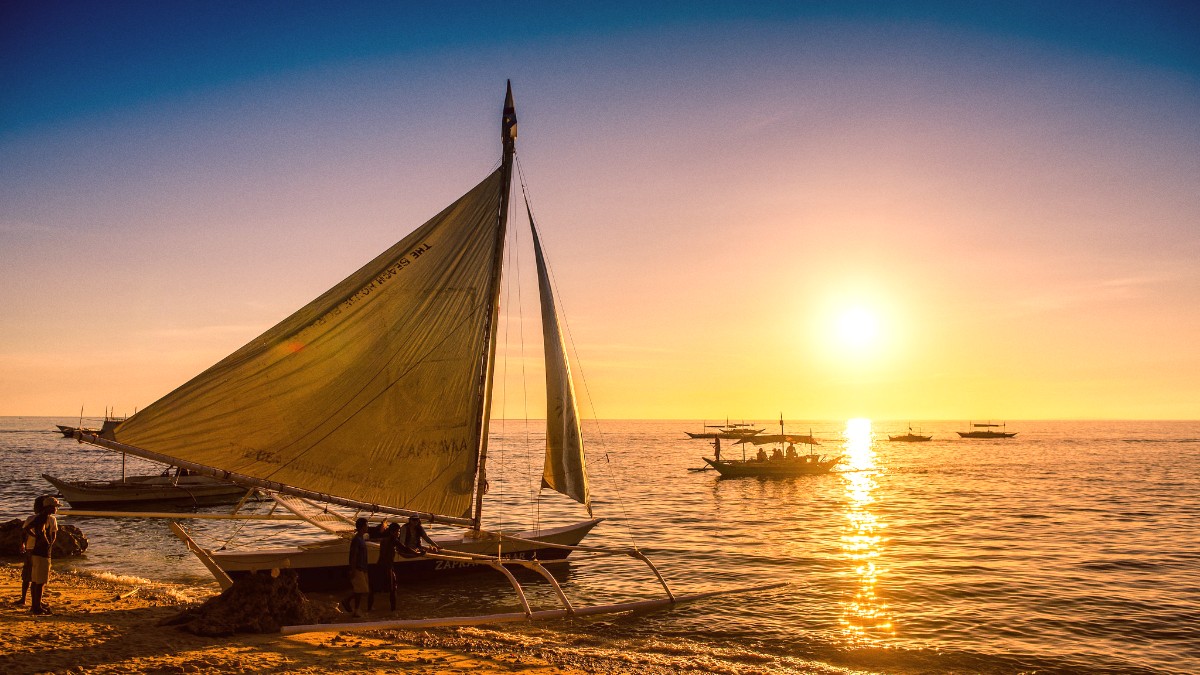
The Visayas, Philippines
Dry Season (Amihan): From November to May, this season presents moderate temperatures, minimal rainfall, and generally calm seas, especially on White Beach. Average temperatures range from 25°C to 32°C (77°F to 90°F). Humidity levels are lower, making for comfortable days. This period attracts many visitors due to its reliably sunny weather.
Wet Season (Habagat): Lasting from June to October, this season brings higher rainfall, stronger winds, and rougher seas. White Beach experiences choppier conditions, while Bulabog Beach becomes ideal for wind-dependent watersports. Occasional typhoons occur. Average temperatures range from 24°C to 30°C (75°F to 86°F). Humidity is higher, leading to a more humid feel.
Monsoons: The Habagat (southwest monsoon) brings substantial rainfall during the wet season. Rain often comes in short, intense bursts, rather than prolonged downpours.
Typhoons: The Philippines experiences typhoons, especially from June to November. Boracay, while not directly in the main typhoon belt, can be affected by strong winds and heavy rains from nearby storms. This can lead to flight and ferry cancellations. Monitor weather forecasts closely.
Peak Crowds, Higher Prices
Best weather, calm White Beach waters, lively atmosphere.
Higher prices for lodging and flights, crowded beaches.
Transition Period
Fewer crowds, lower prices, lush landscape.
Unpredictable weather, some rain likely.
Off-Peak, Best Deals
Significant price drops, minimal crowds.
Higher chance of rain and typhoons, rougher White Beach seas.
No specific vaccinations are mandatory for entry into the Philippines for travelers from most countries, unless you arrive from an area with a Yellow Fever risk.
Consult a travel health clinic or your doctor at least 4-6 weeks before your trip. Common recommendations include routine vaccinations (MMR, DTaP, polio, flu), Hepatitis A & B, Typhoid, Rabies, and Japanese Encephalitis.
Measles, Mumps, Rubella (MMR), DTaP, Polio, Annual Flu.
General travel protection.
For street food or rural area travel.
Consider for animal contact activities.
For extended rural stays during monsoon season.
Review entry requirements before your trip to the Philippines. These can vary based on your nationality and length of stay.
Many nationalities can enter visa-free for 30-59 days. Check the Philippine Department of Foreign Affairs (DFA) website for current lists. If a visa is needed or for longer stays, apply at a Philippine embassy or consulate. A Tourist Visa (9A) is common.
Ensure your passport is valid for at least six months beyond your stay. Proof of a confirmed onward or return ticket is mandatory.
Boracay offers experiences for every budget, from backpacker-friendly options to luxury retreats. The official currency is the Philippine Peso (PHP), denoted by ₱.
This table details estimated daily costs. These figures can vary based on season, specific choices, and individual spending habits.
Plan your budget considering accommodation, meals, transport, and activities. Boracay accommodates varied financial plans.
High season typically correlates with higher costs, while low season presents more budget-friendly options.
A traveler focused on minimizing costs through local food, hostel stays, and public transport.
Daily Total: ₱1,600 - ₱4,100 (~$28 - $72 USD)
Accommodation: ₱800 - ₱2,000 (Hostel bed, basic guesthouse)
A traveler seeking comfort with a balance of value, dining at restaurants and enjoying various activities.
Daily Total: ₱4,700 - ₱13,200 (~$82 - $230 USD)
Accommodation: ₱2,500 - ₱7,000 (Mid-range hotel, resort)
A traveler preferring premium experiences, fine dining, and top-tier accommodations and services.
Daily Total: ₱14,200+ (~$247+ USD)
Accommodation: ₱8,000+ (Luxury resort, villa)
| Category | Budget Traveler (₱/day) | Mid-Range Traveler (₱/day) |
|---|---|---|
| Accommodation | ₱800 - ₱2,000 | ₱2,500 - ₱7,000 |
| Meals | ₱400 - ₱800 | ₱900 - ₱2,500 |
| Activities | ₱300 - ₱1,000 | ₱1,000 - ₱3,000 |
Prepare for common concerns and learn about available resources for a safe journey.
Generally not safe for drinking.
Consume bottled, filtered, or boiled water only.
Many accommodations provide purified water dispensers.
Select clean establishments with high customer turnover.
Avoid uncooked or unpeeled fruits and vegetables from questionable sources.
Ensure all food is cooked thoroughly and served hot for safety.
A clean environment and fresh ingredients are paramount.
Several private clinics operate on Boracay (Station 2, D'Mall areas).
For serious conditions, transport to larger hospitals on Panay Island (e.g., Caticlan or Kalibo) may be necessary.
Several pharmacies, like Mercury Drug, offer prescription and over-the-counter medications.
Boracay is generally safe for tourists, with a low incidence of violent crime. Petty theft, like pickpocketing or bag snatching, can occur.
Boracay is located in a region prone to certain natural events.
Main risk during wet season (June-November). Monitor forecasts; hotels usually have evacuation plans.
The Philippines sits in an active seismic zone. Minor tremors can occur; understand accommodation's plan.
Low tsunami risk (Panay Island offers protection). Storm surges can occur during strong typhoons.